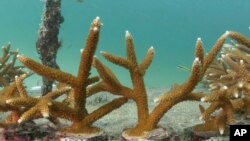Warming and acidifying oceans are destroying the world’s coral reefs and the diverse ecosystems they sustain. Reef habitats have already shrunk an estimated 30% to 50% since the 1980s, and experts say they could vanish almost completely in the next 20 years.
A recent study points to another threat to the survival of coral reefs: sudden drops in oxygen levels.
The study, published in Nature Communications, confirms the observations of scientists working to save coral ecosystems that are home to a large proportion of the word’s marine life.
In September 2017, the study’s lead author, coral reef ecologist Maggie Johnson, was preparing to free-dive in the Caribbean waters off the coast of Bocas del Toro in Panama for the Smithsonian Tropical Research Institute’s long-term monitoring program of coastal ecosystems. While sitting on the anchored boat and putting on fins, Johnson saw calm, clear water. But after diving underneath the surface, she and a colleague noticed something very different.
First, they saw fish clumped together above a well-delineated line of murky water. Then, they spotted languishing creatures on the sea floor: urchins with drooping spines, deflated anemones that were lying flat, sea stars piled on top of each other trying to escape the murky water. After resurfacing, they detected a noxious, foul smell exuding from the water.
“This was unlike anything I’d ever experienced,” Johnson, now a researcher at the Woods Hole Oceanographic Institute, recalled.
Consequences of ocean deoxygenation
Oxygen is an essential component for supporting life. When water temperatures rise, they hold less gas, which explains declining oxygen levels in warming oceans.
On the Panamanian coast, a sudden, localized drop in oxygen in the water had killed a large portion of the reef ecosystem, essentially by suffocating its inhabitants. According to the study, a mix of low wind activity may have caused low oxygenated water to stagnate while nutrient runoffs from agriculture and sewage may have promoted excess growth of algae that further depleted oxygen when they decomposed.
Some marine creatures, such as fish, were able to swim away. Most of them couldn’t escape the dead zone, however. In just days, the sudden deoxygenation event had been catastrophic, according to Johnson.
“There were massive corals that were alive, that were really old. They’ve been there for potentially hundreds of years, and after the event, they were gone,” she said.
Over the next six days of the deoxygenation event, the researchers monitored the reef and collected samples. They found that compared to before the event, the reef had lost half of its coral cover.
The study also reported that a year after the event, species of the community that included corals, sponges and algae didn’t fully recover. The shallower reef, which seemed to fare better than the deeper reef — perhaps due to having more stress-tolerant coral species — showed slow signs of recovery.
“It’s been years since the event, and the ecosystem — particularly down a little bit deeper — hasn’t really recovered. It’s not like this happened, everything died, and then it all came back. It doesn’t come back,” Johnson told VOA.
Microbes, they observed, did seem to regrow in a month after the event and demonstrated a speedier recovery.
Coral bleaching in reefs
Mass coral bleaching events, which can emerge over weeks or months, have been a huge concern for conservationists and ecologists as a leading cause of dying reefs. Warm water can drive coral to expel the colorful algae residing in their hard tissue, turning vibrant habitats a skeletal white.
Bleached coral can still recover, but if too much time passes without their algae residents to feed them nutrients, they’ll starve and die. Or if events become too frequent, the coral will have no time to recover in between.
Stresses from deoxygenation events, as seen in Bocas del Toro’s reef, can also cause coral bleaching. And while deoxygenation events may happen on a smaller scale than warming events, such as within a bay or a lagoon, the speed at which they occur can leave behind a devastated reef within days before response teams can even mobilize or detect them.
“When we think about hypoxic stress, coral reefs are not the first place I think of … but clearly, it happened there,” said Francis Chan, a marine ecologist studying low oxygenation, or hypoxia, in the Pacific Ocean at Oregon State University. “It points a light to (asking) where else in the tropics is this a problem … and are we measuring low oxygen in the right places to see if we can catch these phenomena?”
Strategies for combating low oxygen stress in coral reefs include continuous monitoring, policy changes to address nutrient runoffs, and studying stress-tolerant corals.
“It’s clearer and clearer, based on the science that we have today, that climate change is going to reduce the amount of oxygen that we have in a lot of marine ecosystems,” added Chan. “Do we have climate-ready ecosystems? Do we have climate-ready research and a monitoring enterprise? That’s where we have opportunities to do something.”








